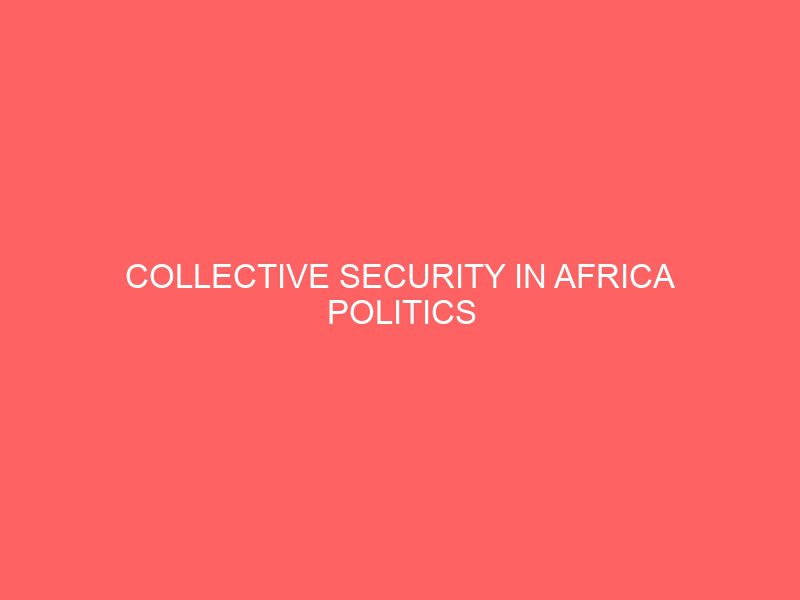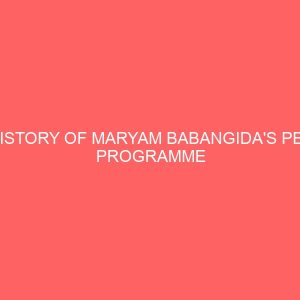Description
CHAPTER ONE INTRODUCTION
Collective security can be understood as a security arrangement, regional or global in which each state in the system accepts that the security of one is the concern of all and agrees to join in a collective response to threats to and breaches of peace1. While collective security is an idea with a long history, its implication in practice has proved problematic. Some pre-requisites have to be met for it to have a chance of working. These pre-requisites according to Morgenthau (1948) are as stated below.1. The collective security system must be able to assemble military force in strength greatly excess to that assembled by the aggressor thereby deffening the aggressor from attempting to change the world order defended by the collective security. 2. Those nations, whose combined strength would be used for deference as mentioned in the first pre-requisite should have identical beliefs about the security of the world order that the collective is defending. 3. Nations must be willing to subordinate their conflicting interests to the common good defined in terms of the common defence of all member states.2 International cooperation to promote collective security originated in the concert of Europe that developed after the Napo/eonic wars in the nineteenth the century in an attempt to maintain the status quo between European states and so avoid war.3 Sovereign nations eager to maintain the status quo willingly cooperate accepting a degree of vulnerability and in some cases of minor nations, also accede to the interest of the chief contributing nations organizing the collective security. Collective security is achieved by setting up an international law and this gives rise to a form of international collective governance, albeit limited in scope and effectiveness. The collective security organization then becomes an arena for diplomacy, balance of power and exercise of soft power. The concept of collective security forwarded by men such as Michael Joseph Savage, Martin Wight, Immanuel Kant and Woodrow Wilson are deemed to apply interest in security in a broad manner to avoid grouping powers into opposing camps and refusing to draw dividing lines that would leave anyone out.4 THE NEED FOR COLLECTIVE SECURITY The United Nations was created after a series of meetings among the Allied Powers in 1945 in San Francisco. It had most of the structures, objectives and functions of the league of Nations.5 The United Nations went a step further hoping to cure the defect of the league of Nations by providing a security council which was in the form of a ‘standing Army’ to enforce the organizations decisions where necessary.6 It later introduced other special agencies (UNICEF, WHO, ILO e.t.c) It is not completely true that the UN has been successful in preventing a third world war conflagration. The effect of the two world wars created a nightmare that needed to be avoid at all cost. Yet, when situations which could have led to this type of crisis emerged like the case of the Cuban Missile crisis7, it was not the UN that initiated a peaceful resolution of the crisis and rather it was the fear of Mutually Assured Destruction (MAD) that gave the super power a rethink8. The end of the Second World War was speeded by the deposit of an atomic bomb in Hiroshima and Nagasaki both of Japan9. Its affected was so devastating, and the possessor (United States) was feared, and respected.10. While the use of Atomic bomb by the US secured victory for the Allied forces, it was not a thing of joy for the soviet union. The Bolshevik Revolution had been frowned at by the West11. This had in turn gives them some reasons to expect a continuous hostility in the immediate post war period. And the only cause of fear was not really the ganging up by the West (US, Britain and France) than by the fact that the US possessed a bomb and also was capable of using it, and would not hesitate using it on Soviet Union. This being the case, between 1945 and 1950, it was a matter of urgency and national security issue for the Soviet Union to develop its nuclear capabilities12. This was in addition to maintaining her newly acquired role in the new post war power arrangement. She needed it to counter the threat, perceived by the United States strategic thoughts in this period. When the Soviet Union acquired nuclear capability in the 1950’s, the United States had to rethink her deterrence, and later complemented it with that of limited warfare13. Nuclear power and thought occupied those powers in the 1950’s and about midway into the 19%. At a point in time, the nuclear strength of the Soviet Union was equal to that of United States and of her allies put together14. The United States had to concede to the new post war status of the Soviet Union. This period presented the most trying period for the United Nations. There were no restrictions on the acts of the super-powers in spite of the security council.15 A number of crises have plagued the UN in this period. The Korean crisis of 1953,16 the Vietnam crisis17, the Congo18, Afghanistan19, Arab – Israeli20 and the hottest being the Cuban missile crisis of 196321. This last crisis saw the world at the verge of destruction, but reason, fear and the reality of the likely outcome restricted. The super powers until the issues was resolved in favour of the wish of United States. Accordingly, the system of collective security as a mechanism for maintaining world peace will continue to be relevant. And so far, there exist no known system capable of replacing it. Outside the crises mentioned about, it has been able to intervene in a number of for third world states and also served as platform for them to interact and air their views in international relations.
COLLECTIVE SECURITY IN AFRICA It has become a consensus of African leaders that security is closely related to development. The African continent has reported relatively more clashes and crises due to problems left over from the colonial age. Relevant statistics show that Africa had been ravaged by more than 30 wars, clashes and riots in the 90’s of the last country alone. So, an idea to set up a joint force for protecting Africa’s security, be it a task force or a high command emerge among leaders of African nations23. Wars and conflicts, or clashes have been reduced drastically on the continent since the entry of the 21st century and the situation with economic growth has been on the whole, but partial security problem is still troubling quite a number of African nations and directly menacing the continents economic development. A case in point is the occurrence of recent riots in Kenya set off during its general election, which has produced a direct negative impact on economic growth in East Africa. The African nations should be said to have made unremitting efforts to beef up the collective unity of the continent for years. The African Union and its predecessors the Organization of African Unity (OAU), have played a vital role in this regard. OAU proposed setting up a peace keeping force composed of armed personnel of African Nations back in the early 1990’s and encouraged its sub-regional organizations to carry out peacekeeping activities. In 2002, AU officially listed the formation of a joint African, defense policy as one of its goals after its replacement of OAU.24. As for concrete moves, the establishment of a reserve force for the whole of Africa has been an objective sought after by African countries for a dozen years. OAY first discussed the formation of quick response task force to cope with crisis in Africa in 1996. Afterwards, leaders of African nations proposed establishing an AU reserve force for performing such tasks as the peacekeeping and humanitarian rescue efforts in the times of needs. To date, the establishment of such a reserve force has been translated not reality gradually. All has so far urged five sub-African regions to organize the respective reserve forces reach supported by a training wing comprising four 750 member units and a 120 member military, observation team.25 Meanwhile, a reserve force of the commonwealth, Southern African Development Community (SADC) was founded in August 2007 with its membership to eventually reach 3,000 to 5,000 and as independent East African Brigade with a membership of some 6,000 is expected to be in place. Of course, there is still a long, long way to go before the complete settlement of Africa’s collective security issue. Although there have been less traditional security issues lying before African nations, their non-conventional security problems, however have been an constant rise. And the role of quick response forces has been hindered owing to their inadequate funding and outdated military equipment and other related factors.26 With a marked progress in the integration process of the African continent, a collective security set up with unique characteristics of the Africa to keep pace with its development is sure to keep improving steadily27. Hence, the security for the entire continent will truly be at the helm of Africans themselves
ENDNOTES 1. Immanuel Kant, Perpetual Peace: A Philosophical Sketch2. Ibid., p 3 3. Ibid., p 5. 4. Skirbekk Gunner et al,A History of Western thought from Ancient Greece to the Twentieths Century. 2001. Pp. 315-317. 5. H.A. Davies, World History, p. 550. 6. Palmer and Perkins, International Relations: The World Community in Transition, p.213.7. H.A. Davies, World History, p. 550. 8. M.A. Orieso, “International Relations since 195” F.I.A. Omu and L.E Otoide, (eds) Themes in International Studies and Diplomacy (Benin City: Department of History and International Studies, University of Benin, (2002), p. 126. 9. Ibid. 10. N. Lowe, Mastering Modern World History (New York: Palgrave – MacMillan, 1997), p. 122. 11. Ibid. 12. Ibid. 13. Baylis, Introduction to Strategies Thoughts, p. 2. 14. Ibid. 15. Ibid. 16. Ibid. 17. Lowe opt.cit. p. 170. 18. Ibid., pp. 150-154 19. Carole Collins, “Cold War Comes to Africa: Cordier and the 1960 Congo Crisis” Journal of International Affairs, Vol. 47, 1993. 20. Lowe opt.cit. p. 170. 21. Ibid., pp 226-242 22. Ibid. pp. 134-137 23. See S.A. Shopeka, “A History of International Organization Since 1919, pp. 330-333. 24. http/www. Seeking Collective Security in Africa pp.1-2. 25. Ibid. 26. Carole J.L. Collins opt.cit







